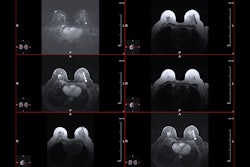
Guidelines that recommend breast screening beginning at age 45 or 50 could leave Black women at a disadvantage, according to a review published on September 4 in the Journal of Breast Imaging.
Two radiologists reviewed breast cancer evidence and found that Black women were more likely than white women to develop breast cancer in their 30s and 40s. What's more, they more often developed aggressive forms of the disease.
This combination of early and aggressive cancer contributed to higher breast cancer mortality rates for Black women, the authors noted. The radiologists worried that starting screening at age 50 could lead to late-stage cancer diagnoses, and worse outcomes, for this racial group.
"Since Black women are more likely than white women to be diagnosed with breast cancer at a young age, initiation of screening mammography should be strongly encouraged by age 40," wrote the authors, Dr. Murray Rebner and Dr. Vidya Pai from the radiology department at Beaumont Health in Royal Oak, MI.
They parsed the literature to investigate whether screening guidelines lined up with the breast cancer experiences of Black women in the U.S. They found that while Black women are actually less likely than white women to develop breast cancer, they are far more likely to die from the disease.
The reasons behind the disparity are multifactorial and complex, but one important factor is that Black women are more likely to develop aggressive breast cancer at ages when screening mammography is not universally recommended.
Nearly 25% of breast cancers in Black women are diagnosed before the age of 50, compared with about 16% of cancers in white women. Despite this higher prevalence, the U.S. Preventive Services Task Force, the American Academy of Family Practice, and the American College of Physicians don't recommend beginning mammography until age 50. Similarly, the American Society of Clinical Oncology and the American Cancer Society advise starting screening at 45.
"Providers who are following national organization recommendations for screening mammography may be inadvertently putting Black women at a disadvantage," the authors wrote.
Black women are more likely to have triple-negative breast cancers, which are harder to treat and can masquerade as benign findings. Triple-negative cancers can also be fast growing and should be screened for with annual mammography, Rebner and Pai noted.
Despite the need for early, frequent screening, Black women undergo mammography and supplemental MRI far less often than their white peers. One study cited by the authors found that Black women had 81% lower odds for utilizing screening mammography, and another study showed that Black women at an increased risk of breast cancer were much less likely to adhere to MRI recommendations.
Numerous reasons contributed to lower utilization rates. Rebner and Pai cited research that found Black women had lower perceived risk of breast cancer, which led to decreased motivation for preventive services. Black women at a high risk of breast cancer were also less likely than white women to have supplemental MRI screening recommended by a provider.
"There are opportunities to improve education about breast cancer risk and utilization of screening mammography as well as screening MRI in those who are at a high risk for breast cancer," the authors wrote.
The authors noted the importance of provider and patient education to address lower utilization rates, but they also stressed the need for consistent national guidelines that advocate for annual screening beginning at age 40.
"Organizations that recommend initiation of screening mammography at age 50 may be putting Black women at a disadvantage given the higher incidence of aggressive cancer diagnosed at a young age in this group of women," they concluded.



















